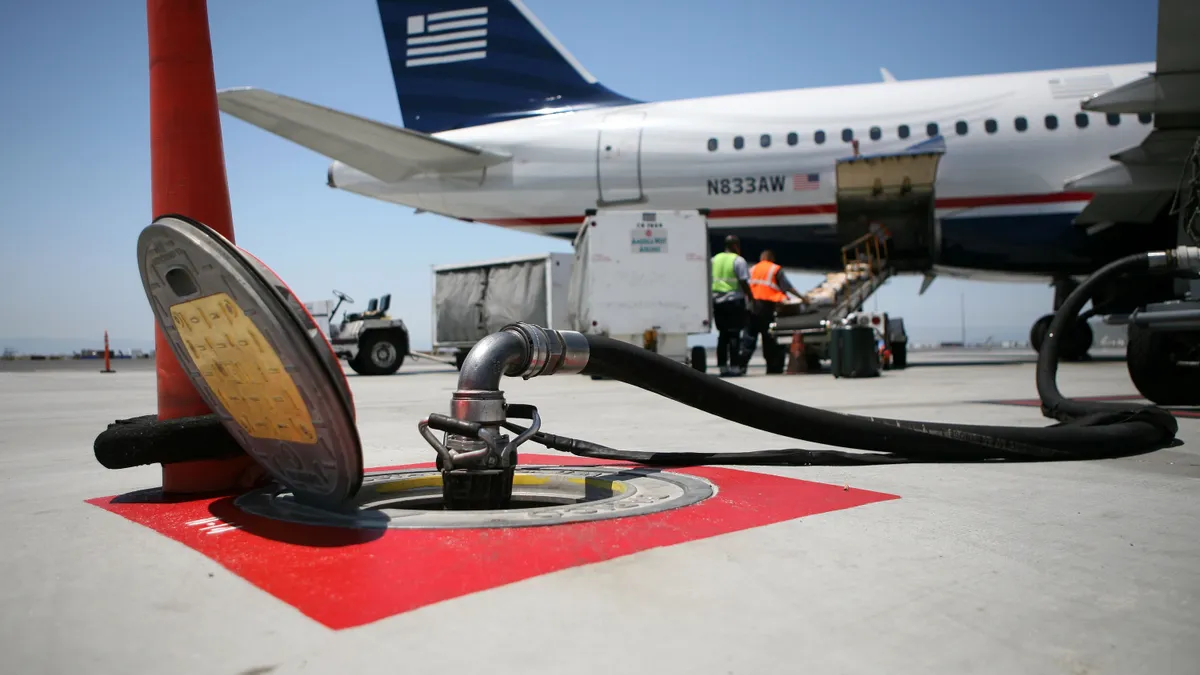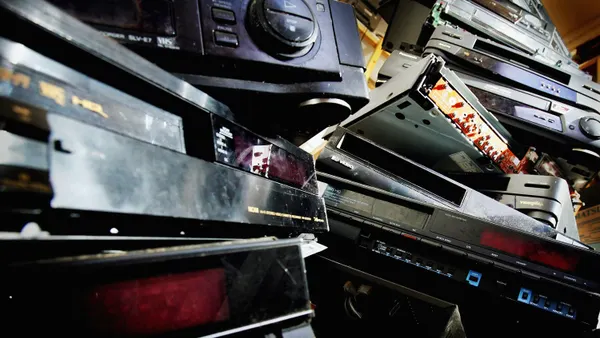As environmental, social, and governance interest and pressures are increasing, waste-to-jet fuel is one of the newer examples of how waste technologies could fit in with ambitious plans to make the aviation industry more "green" while finding disposal alternatives for MSW.
Just outside of Reno, Nevada, Fulcrum BioEnergy's new Sierra biorefinery is projected to produce 11 million gallons a year of syncrude from 175,000 tons of MSW. That syncrude will be refined into SAF (sustainable aviation fuel).
Fulcrum is one of several companies lining up to produce SAFs as the global air industry looks for more environmentally preferable alternatives to conventional jet fuel. International air transportation accounts for 65% of aviation fuel use globally, and aviation CO2 emissions are projected to increase to between 1.1 billion and 1.5 billion metric tons by 2035, according to the International Civil Aviation Organization. Late last year, in recognition of this trend, the United Nations set criteria for SAFs.
The Dallas/Fort Worth International Airport recently began piloting the use of SAF made from used cooking oil, an Air France flight from Paris to Montreal used 16% SAF mixed with conventional jet fuel, IAG (which owns Southwest Airlines and British Airways) recently agreed to buy almost 300 million gallons of SAF from a biorefinery in Mississippi and the Port of Seattle is also exploring a potential MSW-to-SAF project.
Still, the ongoing discussion about sourcing feedstocks, the environmental implications of conversion technology, scale and funding all lead to one unresolved question. Is waste-to-jet fuel truly a sustainable alternative to conventional fuel?
A new plant in Nevada
After a decade of anticipation, Fulcrum completed construction on its Sierra biorefinery in mid-2021.
The company has contracts with WM and Waste Connections to supply the MSW, which will first be delivered to Fulcrum’s processing facility 15 miles down the road by 25-ton tractor trailers. The waste that can be used — which includes textiles, wood, paper, residual plastic and packaging materials — is separated and sized into what Fulcrum Vice President of Administration Richard Barraza describes as a "fluff material which is roughly about an inch in size and almost looks like confetti." That material is then trucked to the Sierra biorefinery. About half of the delivered MSW isn’t usable and gets either landfilled or trucked to a recycling center.
Fulcrum’s waste sorting plant has been active for three years and the biorefinery is expected to create the first batch of syncrude in the second quarter of 2022, said Barraza. The company has product offtake agreements with Cathay Pacific, United Airlines, Marathon Petroleum, BP and World Fuel Services.
There are three phases in the biorefinery: the gasification unit, the gas clean-up area and the Fischer-Tropsch process. The processed waste goes into the gasifier which uses pressure, steam and high temperatures to break it down into syngas, or "simple molecules of primarily carbon monoxide and hydrogen," explained Barraza. That syngas is cleaned in the second step, and the third step is a Fischer-Tropsch catalyst. That reaction creates the syncrude, which in turn will be refined by Marathon. Barraza declined to share where that latter step will be done.
Fulcrum is not the only company looking to profit from waste by making it into SAF. In the U.K., fuel technology company Velocys’ subsidiary Altalto Immingham is planning to build a plant that will turn 500,000 metric tons a year of MSW and commercial waste into SAF using a Fischer-Tropsch catalyst process. The plant, in partnership with Shell, will produce 60 million liters of SAF (mostly synthetic paraffinic kerosene) for jets, as well as "road fuel."
Aviation fuel has high quality standards, which are currently set by ASTM International. They presently allow for a 50% mix of SAF with conventional fuel for commercial aviation, although the regulations for SAF in the U.S. are complex.
"We're very confident when the Sierra project begins producing fuel [this] year that it will meet the specifications required by the aviation industry," said Barraza. "We’ve certainly proven that in our test facilities."
Depending on the method, some estimates show that diesel and jet fuels made from waste have greenhouse gas emission lifecycles almost a half to one third less than conventional fuels, according to research in the journal Environmental Science & Technology.
'Inherently flawed'
While the SAF sector continues attracting investment and interest, some researchers are much less convinced of its potential.
The technology used in waste-to-fuel conversions generally tries to create a pyrolysis process that can make usable chemicals, explained independent researcher Andrew Rollinson. But his research (published in the journal Resources, Conservation and Recycling) details issues with pyrolysis energy from waste products and calls the idea "inherently flawed." This process still uses a lot of high-energy fuel such as diesel or natural gas (Fulcrum’s process uses natural gas) to externally heat the systems because they aren’t self-sustaining.
"It's something that should never ever be considered as being green because it is an energy-consuming process, and you cannot make them work with renewables," said Rollinson.
One problem with the use of mixed waste is it’s so diverse, he said. The result will be a "dirty, black liquid" that requires significant energy to clean. While Fischer-Tropsch is an established process, it needs a very clean gas to work.
"This is the bottleneck in getting that type of quality from gasification," said Rollinson. "In my experience, it's never ever been done. I don't have any optimism that it will be done either."
Additionally, opponents of waste-to-fuel conversion believe that attention and resources should instead be directed toward a broader transformation of transportation systems.
"If you turn plastic or municipal waste back into fuel, then you're creating another source of fossil fuel at a time when we are desperately trying to get ourselves off of fossil fuels," said Neil Tangri, science and policy director at the Global Alliance for Incinerator Alternatives (GAIA). The nonprofit group recently produced a report on jet fuels from MSW, for which Rollinson was the author.
Decarbonizing air transportation will require a huge technological transition that hasn’t started, similar to the development of electric vehicles — which is the direction Tangri believes aviation should go. Instead, he said, the aviation industry is looking for fuels it can use with existing systems and claim they’re environmentally sustainable. "They just want to keep going with business as usual," said Tangri.
The challenges to making fuel from waste include reactor design, the need for improved catalysts and more research on catalyst additives. “Further development of gasification technologies for converting untreated residual wastes and new catalysts to improve selectivity to jet fuel hydrocarbons are needed,” according to researchers who published a paper in Biosource Technology in 2020.
Fulcrum has filed many patents for its technology, but declined to discuss the details of its process or costs of production.
And while aviation fuels do create emissions, research shows most of the industry’s environmental damage comes not from fuel but from associated pollutions. Other research states that nitrogen oxide, carbon dioxide and contrails account for 97% of aviation’s environmental impact.
Kristala Prather, professor of chemical engineering at MIT, said that, optimistically, it will take 20 to 30 years for most existing waste conversion technologies to improve sufficiently and become commercially viable and competitive with conventional fuels.
Crude oil has the advantage of being very consistent, said Prather, so it doesn't need a different refinery process. But the variability of waste as a feedstock needs a process that is "agnostic," because it has to work with a wide variety of inputs.
“There's more diversity in terms of what comes in, and you have to then understand the extent to which your process will tolerate that diversity,” said Prather.
What comes next
As with other governments around the world, the Biden administration’s aviation sustainability plans include SAFs. Investors are lining up.
"There is a growing, global push to decarbonize high-priority sectors of the industrial economy — transportation and the power sector being the highest priorities," said Noah Kaye, a senior research analyst at Oppenheimer & Co who sees increasing opportunities for waste companies to participate in the circular economy. "Waste companies are finding new, higher-value markets than exist currently."
In a sign of this interest, multiple conventional fuel companies are investing in SAFs. BP is an equity partner in Fulcrum with a $30 million investment — as compared with 2021 profit of nearly $7.57 billion. BP has also been investing in various alternative energy projects, like solar, and burnishing its ESG credentials — although not everyone is convinced by the petroleum industry's efforts.
The petrochemical giant has been touting the Sierra project for years, posting promotional spots for Fulcrum in 2017 and 2019 before the first biorefinery was even built. BP declined a request to comment on its involvement with Fulcrum.
For any of these alternative fuel technologies to work, said Prather, they must be robust, consistent and cost-effective. The estimated median prices for some SAFs range from $0.99 to $1.78 a liter, versus around $0.71 per liter (with ongoing fluctuations) for jet fuels. SAFs need to compete with conventional fuels and the cost of oil, but also future energy sources, said Prather. Additionally, regulations and regulatory costs must be factored in.
"A big part of the question marks associated with any alternative fuels is about what regulatory policy is going to be in whatever country you're trying to operate, and whether or not that will work to your advantage towards actually having a cost-effective product compared to what people can do by pumping oil out of the ground," she said.
Amid these broader questions, Fulcrum remains one of the few active examples to assess. Steve Simmons, president at consulting firm Gershman, Brickner & Bratton (GBB) thinks that Fulcrum’s plan is sound.
"It’s a solid waste management option," he said, while cautioning that facilities like Fulcrum’s are very expensive to build. "That leads to being difficult to develop and finance because of the huge amounts of capital that can be required."
Fulcrum’s plant was in development for 10 years. In 2011, Fulcrum filed for an initial public offering that it later withdrew in 2012. In 2014, the Obama administration provided Fulcrum a $105 million loan guarantee to help build its plants and also announced it had signed public-private partnerships with three biorefineries, including Fulcrum. Some of Fulcrum’s funding also came via Nevada tax-exempt municipal bonds, underwritten by Morgan Stanley. Other investments came from SK (a subsidiary of one of Korea’s largest corporations), venture capital firm Rustic Canyon Partners and WM.
Because of the capital investment required, Simmons said that he doesn’t currently expect there to be substantially more MSW converted to transportation fuels.
"It’s towards the higher end of the cost scale, and projects are difficult because they're so big and they need the scale to even get their costs down."
Fulcrum’s Barraza says most of the company’s future biorefineries will be three times bigger than the Sierra facility, churning out 33 million to 35 million gallons of syncrude every year. The next site will be in Gary, Indiana, with construction planned to begin late 2022 or early 2023. Fulcrum announced funding last December, including $375 million in interim financing in the form of revenue bonds from Indiana. The third will be in Texas or Louisiana, he said, and the company is in the planning stages of a facility close to the Manchester Airport in the U.K.
Another factor is community and market demand. Some residents of Gary aren’t too happy about a biorefinery being built on their lakefront and the estimated 100 trucks of waste that will be driving in and out of the area each day to deliver the processed feedstock.
Landfill will likely always be the cheapest option, said Simmons, so alternatives come down to whether communities are willing to pay more for what could be considered a more environmentally preferable waste disposal option.
"I think the answer to that is yes," he said. "Then the follow up question is, well, how much more or how much better protection? We see communities struggle with that all the time."
MIT’s Prather said some of these waste-to-fuel technologies may not offer enough environmental sustainability for the long term, and while transitional technologies have their place in moving away from fossil fuels they don’t always justify the investment.
"I think that's one of the things that we're going to have to deal with increasingly as we try to have this energy transition," she said. "How do you identify those things that are better than the status quo, but not good enough? And then there becomes a question of how much can you afford to invest in that? Because if you're going to have to do better than that too soon afterwards, it makes the investment in the technology not really such a great proposition."
In the meantime, the sector is flying a bit blind due to intellectual property constraints — many of the biofuel companies that own it, like Fulcrum, are private, said GAIA's Tangri.
"These are all proprietary, and none of these companies are disclosing real data," he said. "How much energy goes into this? What's their carbon footprint? What are their emissions? What are their waste products? What's their yield? You know, these are the really critical data that we need if we're going to make a rational decision about how good or bad these fuels are."
Until more public information is available, the true potential of transforming MSW into an aviation fuel — if there is any — remains clouded.










